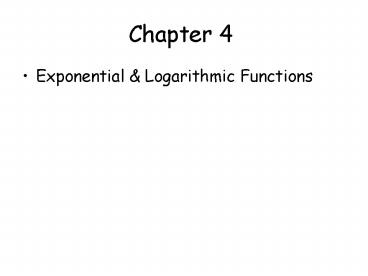Exponential PowerPoint PPT Presentation
Title: Exponential
1
Chapter 4
- Exponential Logarithmic Functions
2
4.1 Exponential Functions
- Objectives
- Evaluate exponential functions.
- Graph exponential functions.
- Evaluate functions with base e.
3
Definition of exponential function
- where b is a positive real number, which is
not equal to 1. As, f(x) 1x is not exponential. - Note that this is not the same as a power
function. Observe the difference between - f(x) 2x and g(x) x2.
4
Graph of an exponential function
- Graph
- As x values increase, f(x) grows RAPIDLY
- As x values become negative, with the magnitude
getting larger, f(x) gets closer closer to
zero, but with NEVER 0. - f(x) is NEVER negative
5
Other characteristics of ______
- The domain of any elementary exponenctial
functions is all real numbers. - The range of any elementary exponential functions
is the positive real numbers. - The y-intercept is the point (0,1) (a non-zero
base raised to a zero exponent 1) - Every elementary exponential function has a
horizontal asymptote y 0. - If the base b lies between 0 1, the graph
extends UP as you go left of zero, and gets VERY
close to zero as you go right. - Transformations of the exponential function are
treated as transformation of polynomials (follow
order of transformations as before)
6
Graph ____________
- First we must draw y2x
- Then shift the graph horizontally to the left by
3 units, to get y 2x3. - Finally, shift the graph vertically down by 4
units, to get f(x). - Note Point (0,1) has now been moved to
(-3,-3) and the horizontal asymptote is y -4.
7
The special base e
- What is e? e is the so called Euler constant,
which is an irrational number not unlike p. The
value of e 2.718, so it is a number between 2
and 3. This is what we call the natural base, as
we are able to model many events in real life
using exponential functions with base e. - Lets graph f(x) ex and then f(x) -e-x
8
Applications of exponential functions
- Exponential growth (compound interest!)
- Exponential decay (decomposition of radioactive
substances)
PowerShow.com is a leading presentation sharing website. It has millions of presentations already uploaded and available with 1,000s more being uploaded by its users every day. Whatever your area of interest, here you’ll be able to find and view presentations you’ll love and possibly download. And, best of all, it is completely free and easy to use.
You might even have a presentation you’d like to share with others. If so, just upload it to PowerShow.com. We’ll convert it to an HTML5 slideshow that includes all the media types you’ve already added: audio, video, music, pictures, animations and transition effects. Then you can share it with your target audience as well as PowerShow.com’s millions of monthly visitors. And, again, it’s all free.
About the Developers
PowerShow.com is brought to you by CrystalGraphics, the award-winning developer and market-leading publisher of rich-media enhancement products for presentations. Our product offerings include millions of PowerPoint templates, diagrams, animated 3D characters and more.

